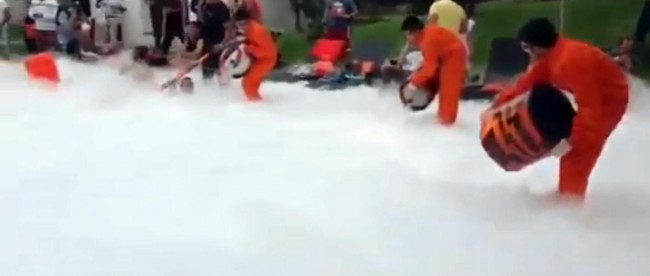The Pool Party That Wasn’t a Gas

As summer unofficially comes to a close, many of us in the U.S. hope to spend the Labor Day weekend by the pool, maybe with a beer or other drink in hand. Here’s some advice: leave the liquid nitrogen at home.
Okay, you probably don’t have any liquid nitrogen in your house — that’s because even though it’s pretty cool (pun not intended), it’s also not the most convenient thing to have around; nitrogen only liquefies as temperatures below −195.79 °C (−320 °F). But when liquid nitrogen “boils” — that is, when its temperature tops that point — you end up with billowy clouds of nitrogen fog which look pretty awesome. (Don’t take my word for it; here’s a video.) And when you’re throwing a big party — one with a big corporate sponsor — the expenses and inconveniences of acquiring, transporting, and using liquid nitrogen are no big deal. On the other hand, huge clouds are awesome — so yeah, you do that.
Unless, again, the event also involves a swimming pool. Because that can lead to tragic results.
That’s what happened at a pool party in Leon, Mexico, in 2013. The event, sponsored by Jägermeister, had promised to be unforgettable, but it turned out to be a nightmare. At one point, organizers decided to dump huge amounts of liquid nitrogen into the pool, as seen below. And as you can see — or, perhaps more accurately, as you can’t see — there’s a pool underneath the newly-formed cloud.

A pretty incredible sight, right?
It was, at first. But then, swimmers began passing out.
As explained by chemistry blog ChemBark (which, unlike a lot of the media reports, gets the science right), the nitrogen doesn’t react with the pool chemicals, but it didn’t have to in order to cause havoc. When the liquid nitrogen came into contact with the pool, the nitrogen warmed up, creating the desired cloud effect, sitting on the top of the water. So far, so good? Not at all. Having a layer of fog sitting on the water’s surface may look neat, but it’s incredibly dangerous if you’re swimming in the water at the time.
As the fog spread across the surface of the pool, it pushed away the oxygen that had been there previously. Swimmers were asphyxiating; all of a sudden, their bodies weren’t getting oxygen, only nitrogen. To make matters worse, ChemBark further noted, the swimmers may not have noticed the lack of oxygen right away, as the burning feeling in one’s throat when you lack air actually comes from an inability to exhale carbon dioxide, which in this case wasn’t a problem. And to make matters even worse than that, if they were flailing around for help, it was hard for people on the outside to notice because the swimmers were surrounded by the fog. (Here’s a video of the event, and you can see people pulling others out of the water toward the end.)
In other words, pouring liquid nitrogen into a swimming pool is a really, really bad idea.
Shockingly, and thankfully, no one died in the incident — but it was close. Nine people were hospitalized and one of them, a young man named Ignacio Lopez de Toro, fell into a coma, but per a Spanish-language report in Milenio (which as of 2025, is no longer online), recovered and left the hospital about a month later.
Bonus fact: While liquid nitrogen shouldn’t be used with pools, using it with cows seems like a good idea. At least, that’s what Ted Dyer, an animal scientist with the University of Georgia argues (pdf). Per Dyer, “freeze branding” cattle — using cattle brands dipped in liquid nitrogen — is often preferable to fire branding, as the animals don’t suffer nearly as much and the brand causes less damage to the cattle.
From the Archives: Cold Water War: When Mao invited Khrushchev to a pool party.
Related: If Jägermeister’s party planners really, really wanted to have an awesome party, and they had $12,000 to spend, here’s a much safer (but life jackets required!) solution.
